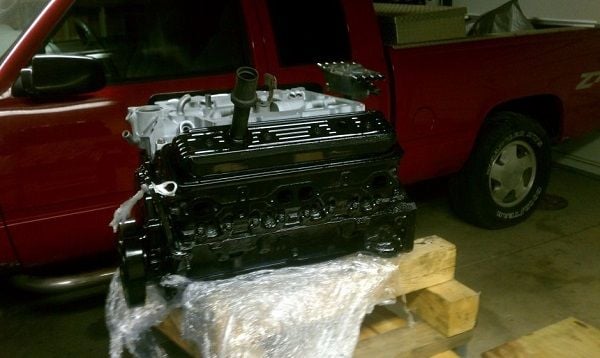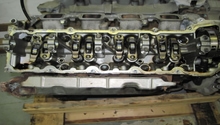Chevrolet Silverado 1999-2006: 5.3L vs. 5.7L V8 Engine Differences
Chevrolet offered the 5.7 liter vortec engine in some of its 1999 C1500 pickups. During 1999 the 5.7 was phased out and GM introduced the 5.3 liter. The reasoning for this transition was to improve on the 1500's fuel economy and reduce its emissions output. Many are happy with the 5.3 liters performance, but some claim the 5.7 liter engine is better suited for towing.
This article applies to the Chevrolet Silverado 1500 GMT800 (1999-2006).
General Motors quickly implemented generation three's 5.3 liter engine into the 1500 around the turn of the century. Government regulations were imposing stricter emissions laws and setting fuel economy goals manufacturers needed to aim for. General Motors implemented new technologies to meet these standards, including elimination of the distributor and development of lighter valve train components.
The 5.7 liter engine developed a great reputation as being reliable and powerful enough to easily tow a load more than the truck's weight. With the implementation of OBD-II computing, this engine used an advanced engine management system for its time. The vehicle control module utilizes twenty different sensors to compute proper delivery of the air/fuel ratio and an optimized ignition system.
In this case, many are pleased with the new sophistication found with the 5.3 liter as this engine can meet the towing needs of most with an increase in fuel economy of 10 to 15%. Even though the 5.3 liter engine is smaller, the engines power ratings are similar. The 5.7 rates at 255 hp and 335 ft./lb. of torque. The 5.3's ratings are 270 hp and 315 ft./lb. of torque with later versions increasing horsepower and torque slightly.
Component Breakdown
5.7 Liter Engine
This engine is fundamentally based from generation one's 5.7. In 1996, GM began implementing the vortec features on there engines. This included redesigned heads for improved combustion and an intake that has better air flow. It also brought about sequential fuel injection that allowed more precise control over the air/fuel ratio. The ignition system found on the 5.7 is comprised of a distributor and driven by the camshaft.

5.3 Liter Engine
The 5.3 liter engine was first implemented halfway through 1999 with technological advantages bringing about better emission ratings and fuel economy. GM rates this engine between 285 to 295 horsepower. Torque is rated at 325 to 335 ft./lb. There are several versions of the 5.3, depending on the year of your truck. In 2003, GM introduced an all aluminum version of the 5.3 called the LM4. This design saved gross vehicle weight improving fuel economy. In 2005, GM developed the L33 high output version equipped with Z06 corvette cylinder heads and a higher lift camshaft.
This engine utilizes coil-on plug design with knock sensors, allowing precise control over each cylinders timing to reduce the effects of detonation and pre-ignition. 2005 models received electronic throttle control improving shift quality and system diagnostics.

Scheduled Maintenance
Engines |
Oil |
Coolant |
Air Filter |
Spark Plugs |
Serpentine Belt |
Timing Chain |
|---|---|---|---|---|---|---|
5.7 Liter |
3,000 miles | 150,000 miles | 30,000 miles | 100,000 miles | 60,000 miles | Life of the truck |
5.3 Liter |
3,000 miles | 150,000 miles | 50,000 miles | 100,000 miles | 150,000 miles | Life of the truck |
If you are unable to find your owner's manual, many manuals can be downloaded free of charge on the web.
Common Questions
Which Engine Has Better Gas Mileage?
Owners of the 5.3 liter engine report back about 15 miles per gallon driving in the city with a 3 to 4 mpg increase during highway driving. 5.7 liter engine owners report 13 to 14 mpg city and 16 to 17 mpg highway. Your results may vary slightly depending on your model (four wheel drive and extended cab models will have slightly lower miles per gallon).
Which Engine is Better Suited For Towing?
The general consensus is that the 5.3 liter will be your better option for towing. Some owners agree that the 5.7 liter provides more initial torque, but the 5.3 liter overcomes this advantage shortly after 3,000 rpms. Thanks to the 5.3 liter's technological improvements, shift points and ignition timing can be altered by the PCM (powertrain control module) to maximize towing performance.
Which Engine is Cheaper to Maintain/Upgrade?
The availability and commonality of the 5.7 liter (350 cubic inch) make replacement and aftermarket performance parts cheaper than the 5.3 liter by 10 to 20%. For example, a set of performance headers for the 5.7 average about $250, while a set for the 5.3 average about $300 to $350.
Common Issues
5.7 Liter Issues
- Intake manifold gasket leak: The intake manifold gasket is notorious for allowing coolant to enter the cylinders and contaminate the spark plugs. This seems to occur between 80,000 and 100,000 miles.
- Fuel pump failure: Fuel pumps have been known to fail (around 100,000 to 150,000 miles). This may be due to incorrect wire size in the fuel pump harness. If the fuel pump fails, the vehicle will not start.
- Factory coolant (pink) needs to be switched to green coolant: The pink coolant is installed from the factory, but is known to cause overheating issues due to its thickening nature over time. Consult with your local GM service center for recommendations, as there has been several changes to GM's "DexCool" coolant over the years.
5.3 Liter Issues
- Cracked cylinder head: The cylinder heads with the cracking condition appear to originate from the manufacturer Castech. If your engine is suffering from a loss in coolant and/or a white foam found on the bottom side of the oil filler cap, you truck may have this issue.
- Knocking sound when the engine is cold: This knocking sound is piston slap occurring because of both carbon buildup and excessive clearance between the piston as well as cylinder walls. This was most common with the model year 1999 to 2001 5.3 engines.
Featured Video: Piston Slap GM Style 2005 Chevrolet Silverado 5.3 Vortec
Technical Service Bulletins (TSB)
- There is one TSB associated with the 1999 C1500 5.7 liter and is listed below:
Service Bulletin Number: 000604045
November 1, 2000
NHTSA Item Number: 616378
This TSB affects the engine and engine cooling. It relates to a ticking sound heard from the engine compartment while driving.
- For the 5.3, there is one TSB that applies to the model years of 2004, 2005, and 2006. 2006 also has two other TSBs.
Service Bulletin Number: PIP-4851
March 1, 2011
NHTSA Item Number: 10037492
This TSB affects the engine and engine cooling. An intermittent check engine light may be present due to five possible internal trouble codes. There may also be an extended crank after filling the fuel tank.
Applies to 2006 Model Years Only
- Service Bulletin Number: 060604042
September 1, 2006
NHTSA Item Number; 10020880
This TSB affects the engine and engine cooling. It relates to throttle actuator codes (P2108, P1516, and U0107). These codes are associated with reduced engine power.
- Service Bulletin Number: 02060
May 1, 2005
NHTSA Item Number: 634283
This TSB affects the engine and engine cooling. Oil consumption appears to be higher than expected.
Related Discussions
- 5.3 vs. 5.7 Vortec - ChevroletForum.com
- 5.3L 1500 - ChevroletForum.com
- Silverado 1500 4x4 MPG - ChevroletForum.com






